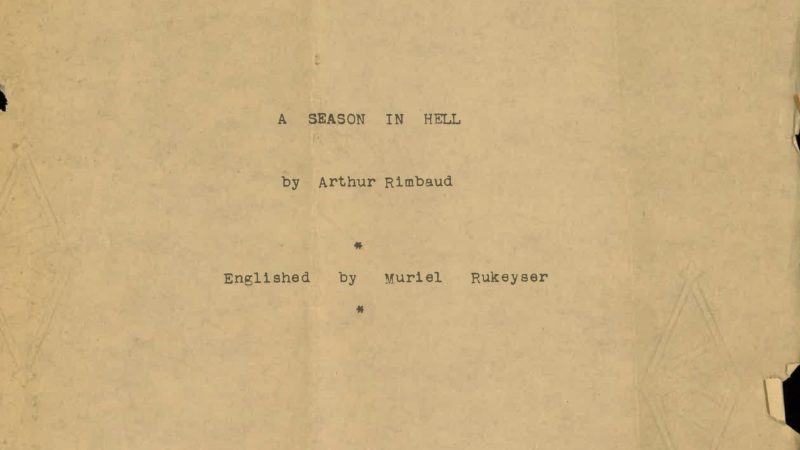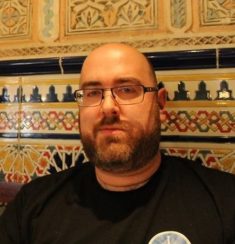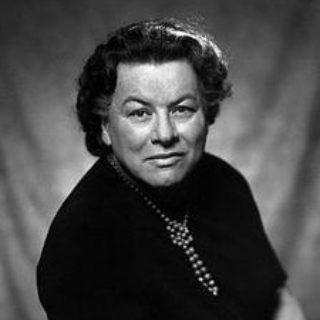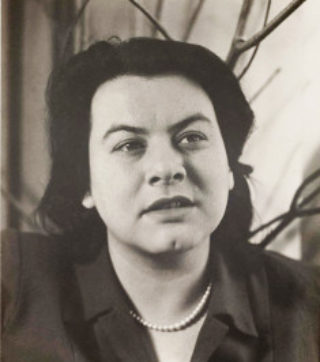Image description: The following text appears typewritten on a yellowed page, with torn and bent edges, "A SEASON IN HELL by Arthur Rimbaud * Englished by Muriel Rukeyser *"
Christopher Clarke
I’m fortunate to have been involved with Lost & Found: The CUNY Poetics Document Initiative for several years now. My interactions with Lost & Found’s other scholars have always been exciting, inspiring, and informative. My academic overlap with some of the projects the group have worked on over past years has been minimal, as I’m a doctoral candidate in the French department, and Lost & Found’s focus has always been primarily on American writers, predominantly writing in English. That said, I’ve been an avid reader of certain of the writers the group has featured for years; when I noticed poets like Ed Dorn and Philip Whalen cropping up regularly, I looked into getting involved.
Lost & Found’s wizard-behind-the-curtain, Ammiel Alcalay, was more than accommodating. I paid him a visit, we met a few times, we started talking over ways I might get involved. After a while, I found we were just talking about books--books and writers that we both love; we have an astounding amount in common. I came to a few group meetings with the other participants, and was amazed at the depth of knowledge, energy, and curiosity involved. Early on, I offered to lend a hand on this project or that project, but things were typically well in hand, work had been delegated, the process was underway and running smoothly.
Eventually, I got the call. It was as if I was being called up to the major league for the first time. Lost & Found alumni Mary-Catherine Kinniburgh, working in the Berg Collection of the New York Public Library, had happened upon something that struck us all as curious: several thin dossiers of translation drafts by New York poet Muriel Rukeyser, who had evidently tried her hand at translating Arthur Rimbaud.
Ammiel reached out to me in March of 2017, asking if I was interested in taking a look. I made a few day trips to New York to visit Mary Catherine in the Berg Collection so as to see firsthand what exactly these dossiers contained. As it turns out, there were two different partial drafts of a translation of Rimbaud’s Une Saison en Enfer (A Season in Hell), and a single translation of Rimbaud’s poem Voyelles (Vowels). A Season in Hell is a long prose poem divided into nine parts, written by Rimbaud between 1871 and 1873; Voyelles is one of Rimbaud’s most famous sonnets, also written in 1871 or 1872. I spent a few days going over the drafts, copied Rukeyser’s Voyelles down very carefully so I could determine which variant she was working from, and then sent my report to Lost & Found: the drafts were unfinished and undated; the earlier of the two was a sixteen-page typescript, hand-corrected, reaching as far as several pages into “Delirium I”; the second incorporated the changes that had been made by hand, and added nearly three additional pages to the first version, ending a page into “Delirium II: The Alchemy of the Verb.”
The mystery was upon us, namely: what we might do with half an undated translation of Rimbaud’s Season? I began by scouring the libraries and the Internet to see if I could find any mention of this aborted project. Some years earlier, I had taken a course at the Sorbonne with a literary historian and philologist who specialized in Rimbaud, and I had also diligently taken a number of 19th century French literature courses over the years, so I was already fairly comfortable with the Season and Voyelles. But beyond Louise Varese’s translation of A Season in Hell for New Directions in 1945, I didn’t know all that much about the history of Rimbaud in English.
The first discovery I made was that there is a published Rukeyser translation of Voyelles, and it turned up somewhere I hadn’t expected: in a seminal text on the cinema. It had been incorporated into Jay Leyda’s 1942 translation of Sergei Eisenstein’s The Film Sense. It was a different version from the draft at the Berg, and as that was the one she chose to publish, a safe bet that it came later, so I had at least a vague timeline for Rukeyser’s translation of Voyelles: sometime in the years leading up to 1942. A comparison of the physical state of the Voyelles draft to those of the Season led me to believe they had been produced at roughly the same time: the paper is very similar, and the typewriter itself had left me certain clues. A progressively smudgy semi-colon. A lowercase “e” that had gradually started looking more like a bullet hole than a vowel. This cursory investigation led me to believe that both texts had been translated sometime in the years leading up to 1942. Beyond that, I was still in the dark.
After consulting with Ammiel and Lost & Found’s editorial consultant Kate Tarlow Morgan, my first inclination was to do something involving a comparative analysis; if Muriel Rukeyser worked on these translations around 1940, what did she do differently as compared to the other translations of Rimbaud published in the same era? And, what could this tell us about how Rukeyser worked as a translator, and explain about her work as a poet? As a literary translator and a scholar who specializes in translation studies, I firmly believe that a writer’s work in translation can never be completely separated from their own creative writing; translation is a creative act, and all interaction between a writer and the page becomes a part of their personal writing experience.
It turned out that Varese’s 1945 translation of the Season was not the only other version. The poet Delmore Schwartz translated it too, also for New Directions, in 1939. And then in 1952, New Directions published a third translation, a revised version by Varese. Suddenly we had a corpus to work with; I began imagining a heavily annotated reproduction of Rukeyser’s translation fragment, comparing her first draft to her second, and to the three published versions that ND had produced between 1939 and 1952. And Voyelles, I thought, would fit quite nicely as a bookend; in fact, the spot where Rukeyser’s draft ended was perfect for this, as the final page of the Season, the first of “Delirium II,” left off with Rimbaud elaborating on exactly what he had been trying to do with Voyelles.
Over the next year, while conducting my own research overseas, I set about transcribing the drafts and preparing the comparison. I compiled a gargantuan Excel sheet that set each line of the eighteen pages of Rukeyser’s draft next to the matching lines from the the other four versions. This detailed grid was to make the process easier when I started to work on my comparison. Once I was back in America the following summer, I started to work learning everything I could about Rukeyser, in hopes that I could avoid missing something telling in her work. I wanted to have a good feel for her poetry, especially her writing up to the late 1940s; her books from before the translation could help me notice any similarities between her own work and the translation, and her books from after the translation could help me notice any similarities between the translation and her own work. I rolled up my sleeves and dove in, staring with Theory of Flight in 1935, and working through to The Green Wave in 1948. I read several volumes of critical work on Rukeyser, including Louis Kertesz’ The Poetic Vision of Muriel Rukeyser (1980); I read Muriel’s own critical volume on poetry, The Life of Poetry (1947). I looked at all of her published translations in hopes that I could get a better read on her as a translator; this included translations from German, Spanish, and Swedish. I read critical examinations of the Rimbaud text itself. As is often the case with a good literary investigation, every clue I found led me to another source with its own questions and clues. I finally got to where I felt comfortable enough with Rukeyser’s work and her biography that I might be able to effectuate such a comparison and contextualize the presentation of such a project in a meaningful way.
Eventually, I set the project aside for a few months while busy with other work, but the time finally came when it was necessary for me to get started on my detailed examination of the five Seasons. I was doing a bit of last-minute digging, trying to clarify a few things, and during this last dive, I was reminded of a detail I had noticed over a year prior: according to the Finding Aid, there were copies of these drafts housed in the Rukeyser Papers at the Library of Congress as well. At least, I assumed they were the same… but it crossed my mind that I ought to make certain. I asked a colleague currently living in Washington, D.C. if, the next time he was working at the Library, he wouldn’t mind swinging past the Manuscript Division to check for me. I sent him a photo of the first page of each of Rukeyser’s drafts from the Berg Collection, and I only had two questions for him: “in the particular box I’ve indicated, in the folder marked Rimbaud, does the first page look like one of these two? If so, please confirm how many pages there are. If not… I’m booking a train ticket and I’ll see you soon.”
“You’ll likely want to come down here,” he told me once he finally made it in. There was a draft that looked completely unlike those I had sent him; there was also a version similar to the ones I had seen, only longer. And there were other things he thought might interest me; turns out the Muriel Rukeyser Papers in the Library of Congress has 94 boxes of materials, and they contain some 30,000 items. I thanked him, reached out to Lost & Found, contacted the Manuscript Room to put an order in for the boxes I most wanted to look through, and then I booked a seat on the Amtrak.
I only had a few days to spare, but I set off to Washington feeling like some distant relative of Sam Spade. Chris Clarke, Translation Detective. I spent about fifteen hours in the Manuscript Reading Room, the staff were pleasant and welcoming. I went through ten boxes of materials, having requested everything I thought might lead me somewhere interesting: all of the containers mentioning translation or the authors Rukeyser translated, and select containers of correspondence, as I still had biographical questions, timeline questions, and other blanks to fill in. But my first task was clear: I went through the folder marked: Rimbaud, Arthur, A Season in Hell, n.d. This was the one that had led me there, after all.
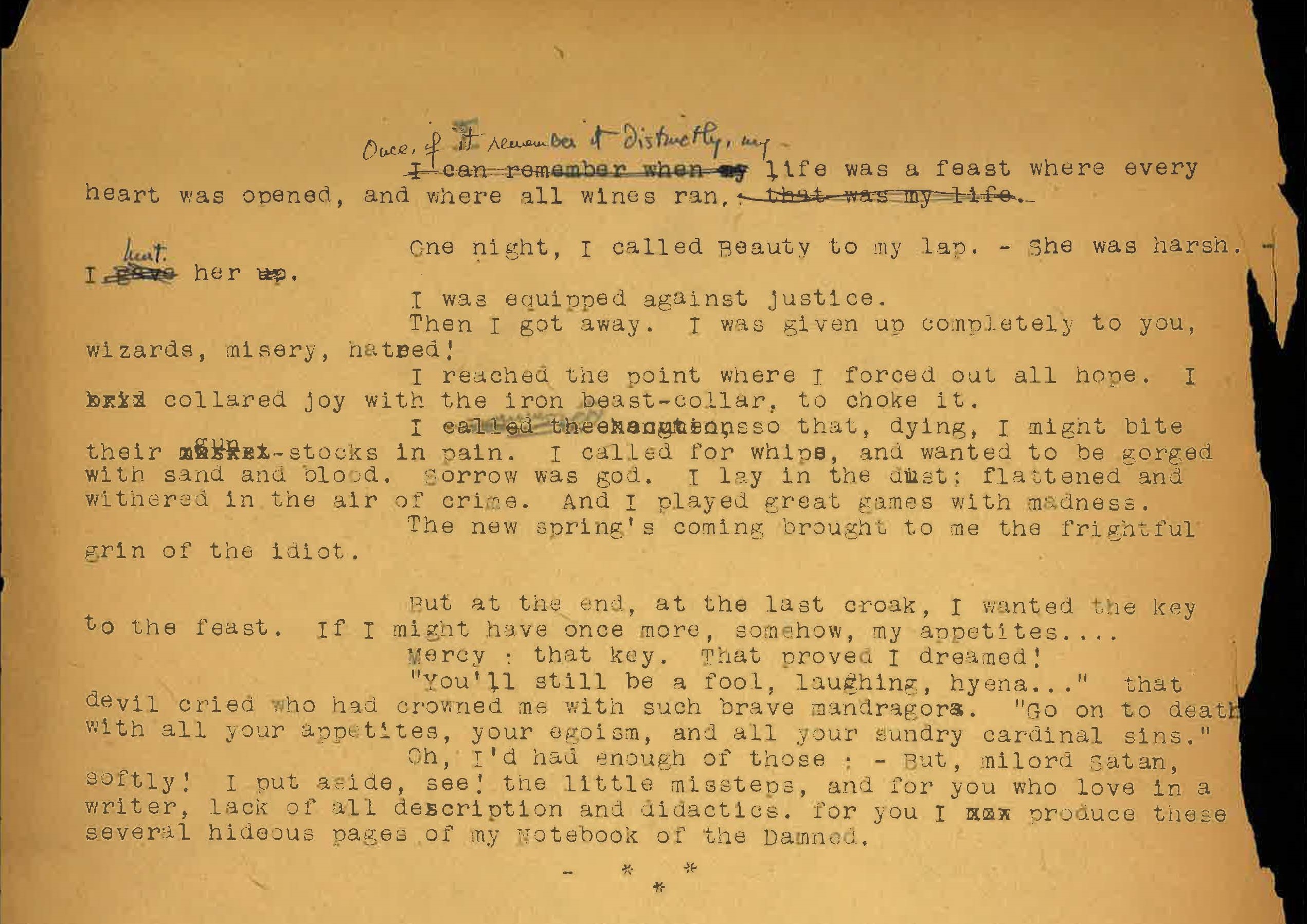
The Rimbaud folder contained two versions of the Season, both different than the two I had examined at the Berg. One was on yellowed, crumbling paper, single-spaced, heavily edited; this, I’ve ascertained, is the initial draft. It is nearly complete: everything except for the verse poems inset in “Delirium II,” these were skipped over, the word “POEM” wedged between prose lines as a placeholder. The second version, however, was an update to what I already had. The same as the second draft housed at the Berg, only with a few new hand corrections, and, most importantly: instead of ending at page seventeen, this one went all the way to twenty-six. To the end. It was complete! With one catch... two pages were missing. I flipped through the pages again and again. 14, 15, 16, 17… 20, 21…
My heart sank. I checked this new draft against the tattered, early draft: the good news was, there were no pages missing from this copy. The bad news? Immediately after page 17 in the new version, where the pagination jumped, is right where the inset poems would have been, and they weren’t present in the oldest draft, meaning I couldn’t use that draft to fill in the blanks. Even though the pages were all there, I would still be missing the poems.
Only I wasn’t. Comparing this final version, the one missing pages 18 and 19, to Rimbaud’s original, I realized there was nothing missing. Perhaps Rukeyser had simply mis-numbered her pages? No, that wasn’t the case either. And then I found it: loose at the back of the Rimbaud folder was a two-sheet document marked “Note on Translation.” A quick read gave me the information I needed.
This is the part at the end of the Columbo episode where Peter Falk explains how he figured it all out. “Just one more thing,” he would say as he turned back to the guilty party. Allow me to explain. First discovery: Muriel Rukeyser didn’t make an error with pagination, she actually translated those two pages twice, likely keeping the framing prose-poem the same in each but replacing the inset poems. She produced alternate versions for the inset poems, either to give the recipient a choice as to which way they should stand, or else to demonstrate the difficulty of their translation. “In submitting alternate versions of the poems,” her note read, “one as close as possible to the literal French version, the other transposing its spirit to our situation in another century, I have offered a concrete example of the difficulties involved.” Perhaps she didn't end up submitting both versions of the two pages. Or, perhaps she did, and whoever it was kept the two they decided worked best, discarding the others. Either way, the pair that remained was the “one as close as possible to the literal French version.” Having examined by this point many of Muriel Rukeyser’s poetry translations, the version present in this draft follows the source text pretty closely, although with some minor deviations that are common enough when a translator is trying to reproduce a strict rhyme scheme.
Second discovery: Muriel Rukeyser did not translate Une saison en enfer in 1940 or 1941, after Delmore Schwartz and before Louise Varese. She translated it in the fall of 1931 or the spring of 1932, and then revised it two years later, in 1933-1934. Her note reads: “The first draft was made during a week of my second year at college […] The revision has been attempted two years later.” Muriel Rukeyser started at Vassar College in the fall of 1930, and was there for two years before she moved back to New York and studied at Columbia. Accordingly, this is the first complete American translation of Rimbaud’s A Season in Hell.
Third discovery: I suspect, and this is purely conjecture on my part, that Rukeyser gave this revised version of the Season to Jay Leyda. In the same folder of papers at the Library of Congress is a typescript version of her translation of Voyelles. It isn’t her typing, as the heading reads, “Muriel’s translation of Rimbaud’s “Voyelles.” This is the published version, its text identical to that found in Eisenstein’s The Film Sense (1942). Below the typescript is a short manuscript note in which the author states, “this absolutely right translation is unknown outside The Film Sense.” The letter is signed “Hear from you soon / See you soon / Talk with you soon / Jay.” I have compared the handwriting of this note to other Jay Leyda manuscript letters, and I’ve no doubt that it is the same Jay, who Rukeyser knew from the mid-1930s through New York documentary film circles. As to whether Rukeyser also gave him the Season along with Voyelles, it’s impossible to say, but the pages ended up together eighty years later.
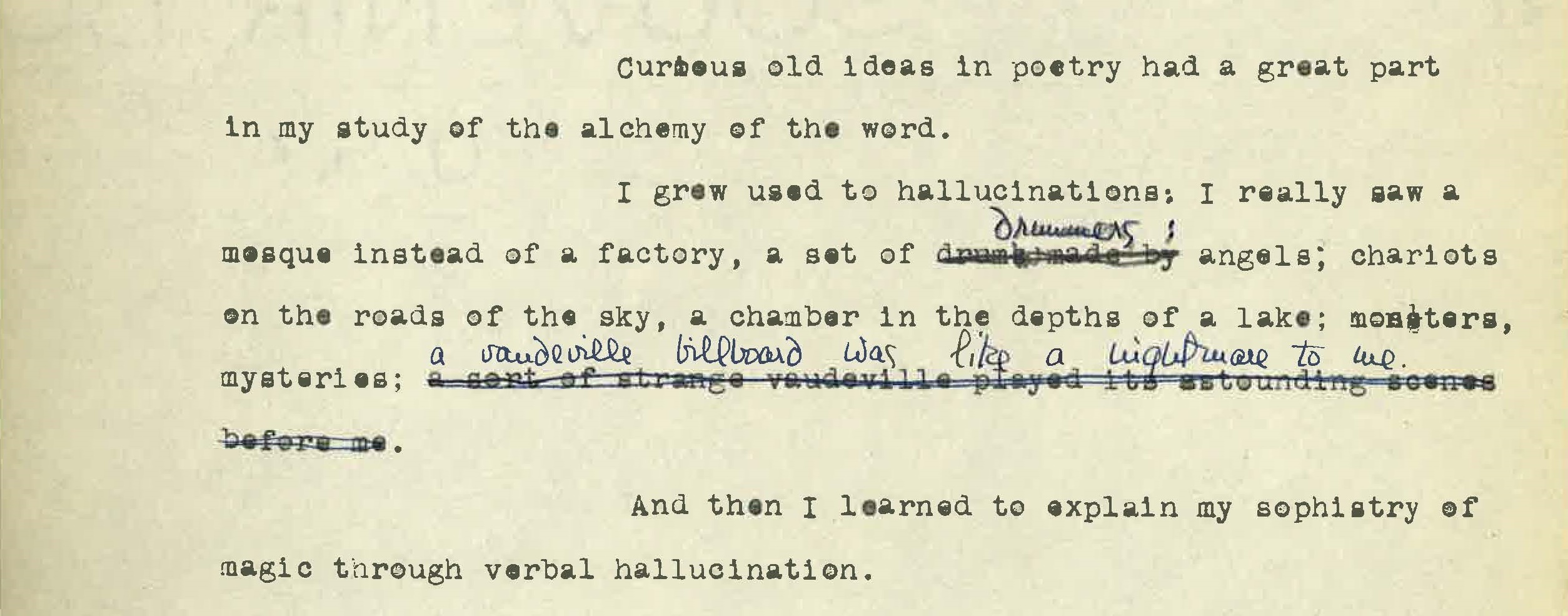
The positive outcome of this little investigation is that we now have the ability to present Muriel Rukeyser’s full translation of Rimbaud’s A Season in Hell to the public, with the very kind permission of William Rukeyser. We have decided to print it as is, only correcting a few errors of an indisputably typographical nature. I have not made any judgment calls as to which passage in which draft is “better,” as that’s not the question at hand. We are reproducing the latest draft we have, as Muriel has left it, right down to her extended ellipses. We will also include the translators note, and the two different versions of Voyelles.
One last mystery remains, however, and that is the Case of the Two Missing Pages. I went through the other translation-related boxes very carefully, but there was no sign of them. When time permits, I will go back to the Library of Congress, and work my way through the eighty-four remaining boxes, looking for a tell-tale “18” and “19” in the upper right-hand corner. I very much want to see her second, more liberal versions of these poems, as they can tell me a lot about how Muriel understood the translation of poetry, at least early in her career. I think I’ve got a pretty good idea of how she worked as a translator, now that I have read her correspondence with Octavio Paz, who she translated for years, and her communications with Leif Sjöberg, with whom she co-translated the great Swedish poet Gunnar Ekelöf. Be that as it may, let’s hope that one day someone comes across 18 & 19, as I’d love the opportunity to see Rimbaud’s images through Muriel Rukeyser’s eyes. Not Rimbaud’s images as he conjured them up in 1873, two years before he quit writing and left France, but Rimbaud’s spirit, transposed to her situation, in her time and place: New York State, sixty years later.
